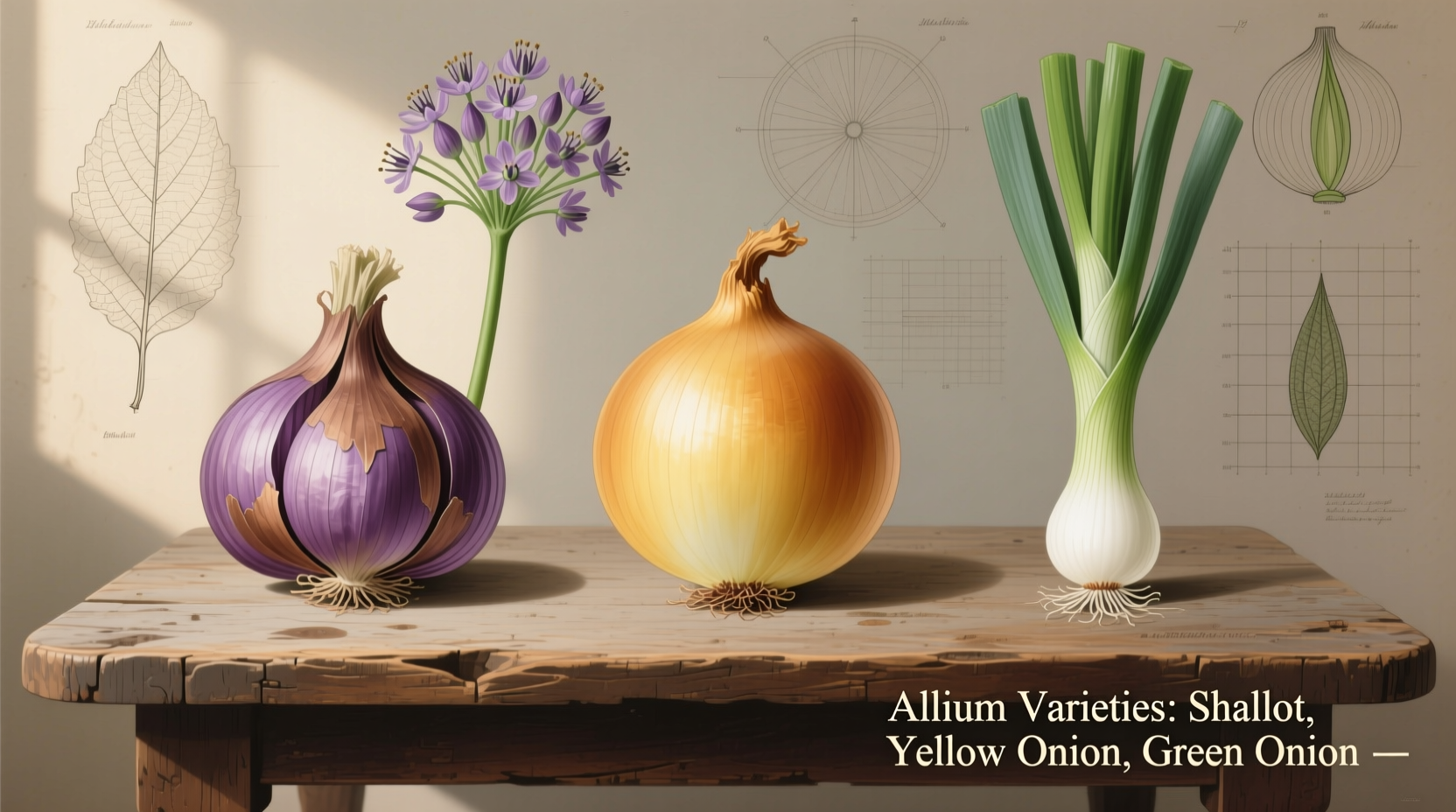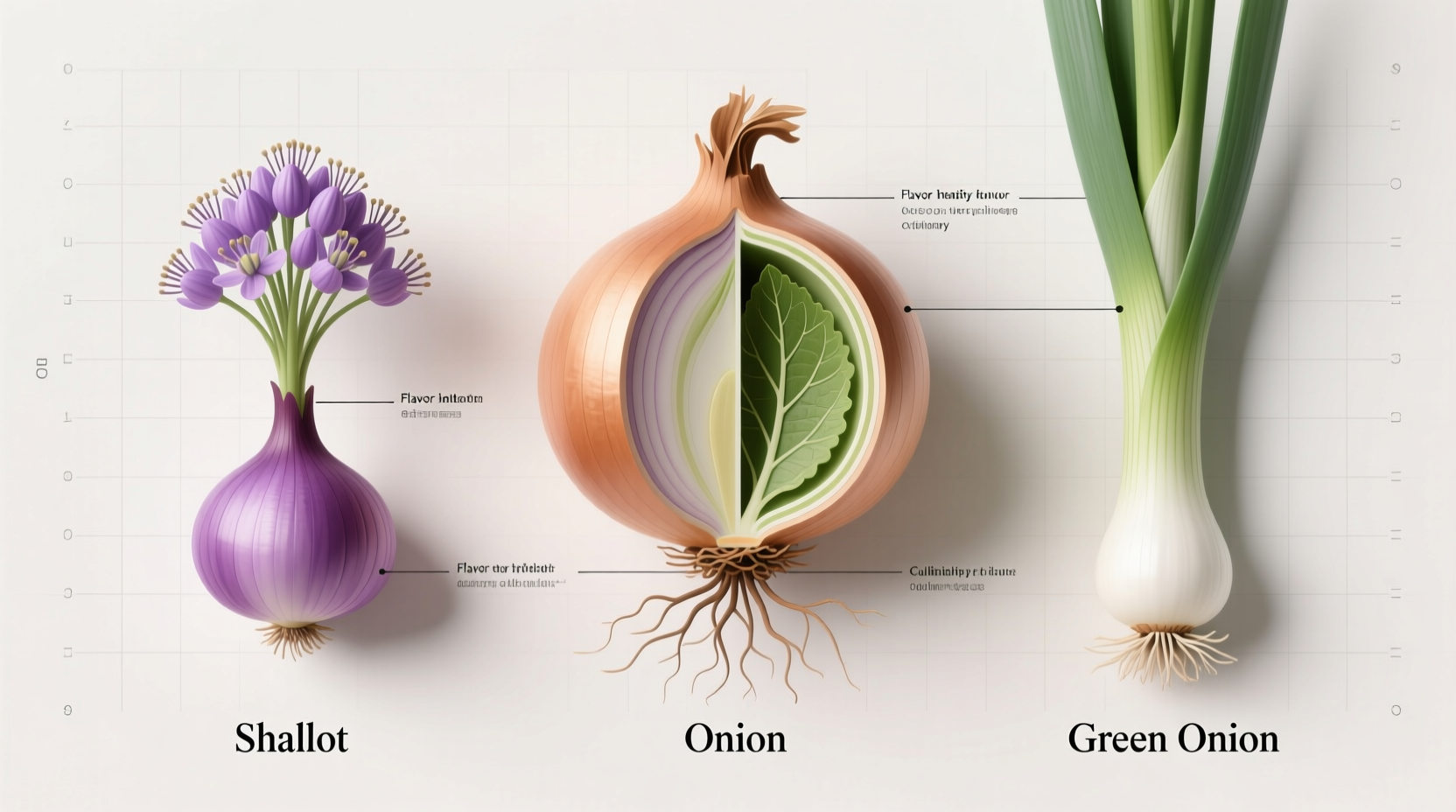Shallots offer a delicate, sweet flavor with subtle garlic notes, onions provide robust pungency perfect for foundational cooking, and green onions deliver fresh, mild onion flavor with edible greens—each serving distinct culinary purposes based on their unique flavor profiles, textures, and cooking properties.
Confused about when to reach for shallots versus onions or green onions? You're not alone. These three allium family members look similar but behave very differently in cooking. Understanding their distinct characteristics helps you make better ingredient choices that elevate your dishes from good to exceptional. Let's break down exactly how these ingredients differ and when to use each one for optimal results.
Understanding the Allium Family: Core Differences
While shallots, onions, and green onions all belong to the Allium genus, they represent different species with unique chemical compositions that affect flavor, texture, and culinary applications. The key difference lies in their sugar-to-sulfur compound ratios, which determine how they taste both raw and cooked.
| Characteristic | Shallot | Yellow Onion | Green Onion |
|---|---|---|---|
| Botanical Classification | Allium cepa var. aggregatum | Allium cepa | Allium fistulosum |
| Flavor Profile (Raw) | Sweet, mild, subtle garlic notes | Sharp, pungent, sulfurous | Mild, fresh, grassy |
| Flavor Profile (Cooked) | Rich, complex, caramelizes beautifully | Sweetens significantly, becomes mellow | Mild, slightly sweet, retains freshness |
| Texture | Firm, layered flesh | Dense, firm layers | Crisp white base, tender green tops |
| Best Cooking Methods | Sautéing, roasting, raw in dressings | Caramelizing, soups, stews, roasting | Finishing garnish, quick stir-fries, raw applications |
When to Use Each Allium: Practical Culinary Applications
Professional chefs select specific allium varieties based on how they'll transform during cooking. Understanding these transformation patterns helps you make smarter ingredient choices for your recipes.
Shallots: The Flavor Enhancer
Shallots contain higher fructose levels than regular onions, creating more complex caramelization when cooked. Their delicate flavor makes them ideal for:
- Classic French sauces like beurre blanc and beurre rouge
- Vinaigrettes and salad dressings (less harsh when raw)
- Finely minced additions to compound butters
- Roasted alongside delicate proteins like chicken or fish
According to culinary research published by the Culinary Institute of America, shallots maintain their structural integrity better than yellow onions during slow cooking, making them superior for dishes requiring long simmering times without disintegration.
Yellow Onions: The Workhorse Ingredient
Yellow onions contain more sulfur compounds, creating that characteristic pungency that transforms into rich sweetness when cooked. They're perfect for:
- Caramelizing (takes 30-45 minutes for proper development)
- Building flavor foundations in soups, stews, and braises
- Roasting with heartier meats like beef or pork
- Grilling (hold their shape well)
USDA FoodData Central confirms yellow onions contain approximately 4.2g of sugar per 100g, which explains their superior caramelization properties compared to other varieties. When properly caramelized, their natural sugars develop over 500 flavor compounds that create that rich umami depth.
Green Onions: The Fresh Finishing Touch
Green onions (also called scallions) offer a completely different culinary profile with their mild flavor and dual-textured structure. Use them for:
- Garnishing finished dishes (both color and flavor)
- Asian stir-fries added at the very end of cooking
- Raw applications like salads, salsas, and dips
- Infusing oils and vinegars with fresh onion flavor
Unlike bulb onions, green onions contain significant amounts of chlorophyll in their green portions, contributing fresh, grassy notes that complement rather than dominate dishes. Their white bases can withstand brief cooking, while the greens should be added raw for maximum flavor impact.
Substitution Guide: When You're Missing an Ingredient
Running short on one allium variety? Here's how to substitute effectively while maintaining dish integrity:
- Shallot substitute: Use 1 small yellow onion + 1 minced garlic clove per shallot. For raw applications, sweet onion works better than yellow.
- Yellow onion substitute: 1 shallot equals about ½ small yellow onion. For raw applications, sweet onion is preferable.
- Green onion substitute: Use chives for garnish, or leek whites for cooking applications requiring similar texture.
Important note: Never substitute green onions for shallots or yellow onions in recipes requiring long cooking times—they'll become unpleasantly mushy and lose their delicate flavor. Similarly, avoid using yellow onions where green onions are specified for raw applications; their stronger flavor will overwhelm the dish.
Nutritional Comparison: Health Benefits Beyond Flavor
All alliums offer health benefits, but their nutritional profiles differ slightly:
- Shallots contain the highest concentration of flavonoids, particularly quercetin, with approximately 26.5mg per 100g according to USDA data—nearly double that of yellow onions.
- Yellow onions provide more vitamin C and chromium, which helps regulate blood sugar.
- Green onions offer significant vitamin K (from the greens) and vitamin A precursors, with the green portions containing up to 8 times more vitamin C than the white bases.
All three contain organosulfur compounds associated with cardiovascular benefits and anti-inflammatory properties. However, the specific compounds vary, making culinary diversity beneficial for maximum health impact.
Storage and Preparation Tips
Proper storage maintains flavor and extends usability:
- Shallots: Store in cool, dark, dry place for 1-2 months. Do not refrigerate. Peel by cutting off ends and removing papery skin.
- Yellow onions: Keep in mesh bag in cool, dark place for 2-3 months. Refrigeration causes moisture buildup and spoilage.
- Green onions: Trim roots, store upright in jar with 1 inch water, covered with plastic bag in refrigerator. Change water every 2-3 days for up to 10 days of freshness.
When preparing, always cut against the grain (perpendicular to growth rings) to minimize tear-inducing compounds. For raw applications, soaking sliced onions in ice water for 10 minutes reduces pungency while maintaining crunch.
Common Mistakes Home Cooks Make
Avoid these frequent allium errors that compromise your dishes:
- Using the wrong variety for the application—yellow onions in salsa, shallots for caramelizing in large quantities
- Improper storage—refrigerating dry onions, leaving green onions loose in produce drawer
- Overcooking green onions—adding them too early in stir-fries
- Not adjusting quantities when substituting—using equal amounts of yellow onion for shallots
- Discarding green onion tops—the greens contain valuable nutrients and flavor
Professional chefs emphasize that understanding these ingredients' limitations is as important as knowing their strengths. For instance, shallots' delicate flavor gets lost in long-cooked tomato sauces where yellow onions provide better foundational flavor.

Putting It All Together: Real Kitchen Applications
Consider these practical examples that demonstrate proper allium selection:
- French Onion Soup: Yellow onions are essential—their higher sulfur content creates the deep, complex caramelization required for authentic flavor.
- Vinaigrette: Shallots provide balanced flavor without overwhelming acidity—yellow onions would be too harsh raw.
- Stir-fried Noodles: Green onions added at the end provide fresh contrast to rich sauces, while yellow onions would dominate the delicate balance.
- Roast Chicken: Shallots roasted alongside chicken create delicate flavor without overpowering the meat, while yellow onions would create stronger background notes.
Mastering these distinctions transforms your cooking from following recipes to understanding the why behind ingredient choices—a fundamental skill that separates novice cooks from confident home chefs.











 浙公网安备
33010002000092号
浙公网安备
33010002000092号 浙B2-20120091-4
浙B2-20120091-4